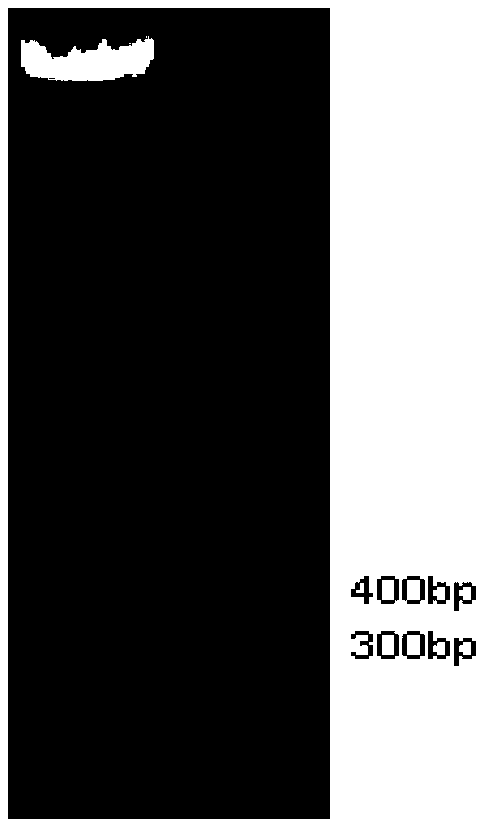Exogenous-gene removable slow virus controlled expression carrier system and application
A technology for expressing vectors and exogenous genes, applied in the field of genetic engineering, can solve the problems of decreased expression of exogenous genes, causing host immune response, non-integration of exogenous genes, etc., to achieve the effect of avoiding interference
- Summary
- Abstract
- Description
- Claims
- Application Information
AI Technical Summary
Problems solved by technology
Method used
Image
Examples
Embodiment 1
[0042] Cloning of embodiment 1 Tet-response element (TRE) and the most simplified CMV promoter sequence (TREminiCMV)
[0043] Use a plasmid extraction kit to extract the plasmid in JM109 / pTRE-Tight, use it as a template, and obtain the TREminiCMV sequence by PCR amplification. The primers used are as follows:
[0044] TREminiCMV-For: 5’-GAG GG G ATC CC T TTC GTC TTC ACT C-3' (the primer sequence is shown in SEQ ID NO: 1), the underlined part is the BamH I restriction endonuclease recognition site;
[0045] TREminiCMV-Rev: 5'-CGA GAT ATC GAA TTC TCC AGG CGA TC-3' (the primer sequence is shown in SEQ ID NO: 2), the underlined part is the EcoR V restriction endonuclease recognition site;
[0046] The PCR reaction system is: pTRE-Tight1μl, 10μmol / L upstream and downstream primers 1μl each, 2.5mmol / L dNTP4μl, 10×Pyrobest Buffer 5μl, 5U / μl Pyrobest DNA polymerase 0.5μl, add double distilled water to make up 50 μl.
[0047] The conditions of the PCR reaction were: pre-denatura...
Embodiment 2
[0050] Example 2 Cloning of green fluorescent protein (EGFP) cDNA
[0051] Using the pBMN-GFP plasmid as a template, EGFP cDNA was amplified by PCR, and the primers used were as follows:
[0052] EGFP-For: 5'-CGA GAT ATC ATG GTG AGC AAG GGC GAG-3' (the primer sequence is shown in SEQ ID NO: 3), the underline is the EcoR V restriction endonuclease recognition site;
[0053] EGFP-Rev: 5'-CGC GAC CCT TGG TC T TAC TTG TAC AGC TCG-3' (the primer sequence is shown in SEQ ID NO: 4), the underline is the Ahd I restriction endonuclease recognition site;
[0054] The PCR reaction system is: pBMN-GFP1μl, 10μmol / L upstream and downstream primers 1μl each, 2.5mmol / L dNTP4μl, 10×PCR Buffer5μl, 5U / μl rTaq DNA polymerase 0.5μl, add double distilled water to make up 50μl .
[0055] The conditions of the PCR reaction were: pre-denaturation at 94°C for 4 minutes; denaturation at 94°C for 30 seconds, annealing at 56°C for 30 seconds, extension at 72°C for 1 minute, and 35 cycles; final ext...
Embodiment 3
[0058] Mutation of embodiment 3 LTRU3 region and insertion of loxp sequence
[0059] The site-directed mutation of ACCGGT in the 3'LTR U3 region of the pSMPUW vector, the mutated sequence is ACGCGT, and the Mlu I restriction site is introduced. The vector plasmid mutation primers are as follows:
[0060] Mut-For: 5'-TTG CTT TAT T TG TAA ACG CGT GCA GCT GCT-3' (the primer sequence is shown in SEQ ID NO:5);
[0061] Mut-Rev: 5'-TAG CAT CAC AAA TTT CAC AAA TAA ATT CCG-3' (the primer sequence is shown in SEQ ID NO:6);
[0062] The reaction system is: 0.5 μl of pSMPUW plasmid, 1 μl of 10 μmol / L upstream and downstream primers, 4 μl of 2.5 mmol / L dNTP, 5 μl of 10×Pyrobest Buffer, 0.5 μl of 5 U / μl Pyrobest DNA polymerase, and 50 μl of double distilled water .
[0063] The conditions of the PCR reaction were: pre-denaturation at 94°C for 5 minutes; denaturation at 94°C for 30 seconds, annealing at 60°C for 30 seconds, extension at 72°C for 7 minutes and 30 seconds, and 35 cycles; fi...
PUM
 Login to View More
Login to View More Abstract
Description
Claims
Application Information
 Login to View More
Login to View More - R&D
- Intellectual Property
- Life Sciences
- Materials
- Tech Scout
- Unparalleled Data Quality
- Higher Quality Content
- 60% Fewer Hallucinations
Browse by: Latest US Patents, China's latest patents, Technical Efficacy Thesaurus, Application Domain, Technology Topic, Popular Technical Reports.
© 2025 PatSnap. All rights reserved.Legal|Privacy policy|Modern Slavery Act Transparency Statement|Sitemap|About US| Contact US: help@patsnap.com



